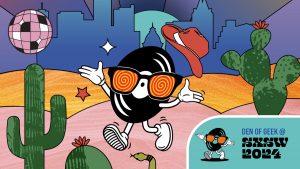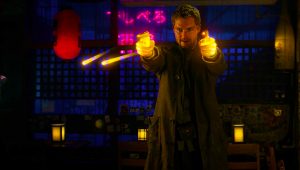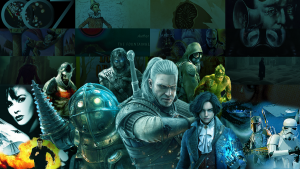
In the modern video game industry, almost every developer and publisher has their eyes on starting a franchise from day one of development. Features get cut that would fit better in a sequel. Plot points are set up for a future game. If you can franchise something, you can make a lot more money.
But sometimes, those plans don’t quite work out. A game sells well, a sequel gets greenlit, and for whatever reason, it barely makes a dent in the gaming consciousness, or maybe it never even makes its way to the West. Some of these sequels were stumbling blocks in bigger franchises, or offshoots that got stuck on platforms with small userbases. And a few seemed poised for bigger things but never quite caught on. Regardless of the how or why, these are some of the most notable video game sequels you probably forgot existed.
15. NBA Elite 11
By 2010, EA’s venerable NBA Live series was getting consistently beaten in sales and reviews by the NBA 2K games. So, the decision was made to reboot the series as NBA Elite: a basketball title with a brand new control scheme and single-player “Become Legendary Mode.” This sounded great in theory, but a short development cycle and a glitch-filled demo that was made available on Xbox Live and the PlayStation Network quickly made what should have been an easy layup into an online laughingstock.
EA technically canceled the game just a few weeks before release, but a few PS3 copies have made it out into the wild. If you can find one, expect to drop several thousand dollars on it. As for the NBA Live series, it never quite recovered from the debacle. EA didn’t ship another NBA title until 2013, and NBA Live 19 has been the last title in the series so far, with no word on when, or if we might see another follow-up.
14. Zone of the Enders: The Fist of Mars
A lot of gamers are familiar with Zone of the Enders: an awesome mecha action game created by legendary game director Hideo Kojima in the early 2000s. You can even find the HD remasters and VR port of the second Zone of Enders game pretty easily. While another sequel was announced and scrapped (and something we’ll likely never see again given the falling out between franchise owner Konami and Kojima), there is already a third, lesser-known game in the series floating around out there.
The Fist of Mars was only released for the Game Boy Advance way back in 2002, and it’s radically different from the other two Zone of the Enders games. The story is told in an episodic format similar to an anime, and combat is turn-based and in the first-person. Despite the changes, it’s an excellent strategy game in its own right, and it’s kind of surprising that Konami hasn’t re-released it in some form given how easy it would be to port.
13. Fade to Black
You’ve probably at least heard of Flashback: an early cinematic platformer in the same style of Another World and the first Prince of Persia. It’s a bit clunky nowadays, but it looked absolutely mind-blowing back in 1992. A direct (and curiously terrible) sequel, Flashback 2, was even released on modern platforms in 2023. But that wasn’t the first Flashback sequel.
Fade to Black stars Conrad Hart, the protagonist of the first game, but moves the action to 3D and ditches the Flashback name. It was widely praised at the time of release in 1995, and the animation holds up pretty well today. Unfortunately, this is a very rough game to go back to now, whether you check out the PS1 or PC version.
12. Dragon Force II
The original Dragon Force remains one of the best reasons to track down a Sega Saturn. Part RPG, part real-time strategy game, you pick from one of eight rulers vying for control of Legendra, seeking to grow your kingdom either by negotiation or battle. You can set 100 dragon troops against 100 zombies on the field and watch them go at it in all their sprite-based glory.
The Japan-only sequel is a lot like the first game (not necessarily a bad thing) but with more abilities, and the option to have two different types of troop units fighting for you in any given battle. Despite wide critical acclaim, neither game is very well known, and there seems to be zero interest from the rights holders in bringing them to modern platforms.
11. Civilization Revolution 2
Civilization Revolution was itself a spin-off of Sid Meier’s beloved Civilization series. Built for consoles and mobile, it was intended to be a brisker, more streamlined version of the game that included most of the strategic elements of the mainline games, but with more accessibility and simpler controls. And it absolutely worked. It remains a hidden gem of the Xbox 360 and PS3 era.
Civilization Revolution seemed primed to be another hit franchise for Firaxis and 2K Games. So, they did the only sensible thing and waited six years before releasing a sequel exclusively on iPhone and Android. Oh, and then they ported it to the PS Vita in 2016 when the handheld was on its last legs. Then again, maybe that was for the best. While by no means a bad game, Civilization Revolution 2 doesn’t do much different from the original. If anything, the game’s AI is noticeably worse. Still, if you loved the first game and always wanted a sequel, now you know it is out there at least.
10. Lunar: Dragon Song
Originally released in the ‘90s for the Sega CD and PS1, the first two Lunar games remain favorites among JRPG aficionados. They’re a pair of really solid turn-based games with witty writing set on a charming world orbiting a barren blue rock. For years, fans demanded more Lunar, and in 2005 they finally got their wish when Dragon Song hit the Nintendo DS.
Unfortunately, the developers seemed to forget what made Lunar such a fan favorite in the first place with this sequel. Dragon Song is full of bizarre design choices like losing health when you dash and having to choose between either experience points or items after a battle. Not only is Dragon Song largely dismissed by fans of the Lunar series, but it’s widely considered one of the worst JRPGs ever made.
9. Okamiden
Okami was Capcom’s awesome spin on the Zelda formula. It was a storybook-like tale about a wolf steeped in Japanese folklore, with an innovative celestial brush gimmick that helped it stand out in a crowded field. It was immediately praised as a classic when it was released for the PS2 in 2006, but coming out that close to the release of the PS3 meant many gamers overlooked it until it was re-released years later for other platforms.
While Okami has finally gotten its due, many gamers forget it already has an excellent sequel. Okamiden focuses on the children of characters from the first game. Unfortunately, Capcom repeated the same mistakes they made with the original, this time releasing it late in the lifecycle of the Nintendo DS. Even worse, we still haven’t gotten an HD re-release of Okamiden.
8. The 3rd Birthday
Two of the most underrated games released during Square’s golden age in the ‘90s were the Parasite Eve duology for PS1. The first title’s opening (in which an entire opera audience spontaneously combusts simultaneously) is still one of the best openings in gaming history. And things just get weirder as the games progress, with both tiles nailing a really cool Final Fantasy-meets-Resident Evil vibe.
Over the years, Square Enix lost the rights to the Parasite Eve name. Yet, they still pushed ahead with a sequel, which is how we ended up with the curiously named The 3rd Birthday. While technically a Parasite Eve sequel, it barely feels like one. This PSP exclusive shifts the gameplay to third-person shooting and the story barely connects to the first two games (aside from keeping the protagonist Aya Brea). It’s an ok standalone game, but it never comes close to the heights of the first two titles, and it doesn’t sound like we’ll be seeing more adventures with Ms. Brea anytime soon.
7. Boktai 3: Sabata’s Counterattack
Game cartridges had plenty of issues (like the chronic lack of space), but they also allowed for some really unique innovations. One of the most novel was Boktai’s light sensor. Springing from the mind of Hideo Kojima, the Boktai games are action RPGs starring a vampire hunter, but with the twist that the game is much easier to play during the day since you can more easily recharge your solar gun weapon with the sensor. If you run out of light, you’ll have to avoid enemies.
The first two Boktai games were released in the United States to widespread critical acclaim, but poor sales of the second game meant Boktai 3 never saw release outside of Japan. That’s a shame, because it has a heavier emphasis on action and also introduces swords, along with some neat motorcycle sections. A fan translation can be easily found online, but the light sensor requirement of the game means playing it on an emulator just isn’t quite the same.
6. SimCity 64
If you grew up in the ‘90s, odds are you played some version of SimCity. Whether it was one of the PC games (or the excellent SNES port), SimCity was everywhere during that time. However, you’ve probably never played the version made exclusively for the N64’s 64DD add-on. Does this version do anything particularly notable? Not really, but it’s very playable and the 64-bit graphics still hold their charm more than two decades after release.
Given how much work went into SimCity 64 (and how many other games intended for the 64DD were moved to the Nintendo 64 proper), it’s surprising that the game never saw a cartridge release. It really is the crown jewel of the 64DD lineup, which admittedly isn’t saying much considering that only nine games were released for the add-on and most of those were Mario Paint titles. But given that Nintendo has been more willing to release obscure, formerly Japan-exclusive titles online lately, maybe there’s some hope we’ll finally see SimCity 64 hit Nintendo Switch Online soon.
5. Nights: Journey of Dreams
As many issues as Sega had in the ‘90s, the company was still capable of making some amazing games. Perhaps none were better than Nights Into Dreams: an early Sega Saturn game that was part platformer, part racing game set in a surreal dream world. Nights was the closest thing the Sega Saturn had to a killer app. It was an innovative 3D game with absolutely gorgeous graphics and one of the greatest soundtracks of all time.
A sequel was immediately planned for the Saturn, and then the Dreamcast, but following Sega’s exit from the hardware business, Nights didn’t fly again until the 2007 Wii release, Journey of Dreams. I don’t want to be too hard on Journey of Dreams because a lot of care clearly went into this game. Much of the original team even returned to work on this title. At the end of the day, though, it just doesn’t recapture the magic of the first game. The levels and music just aren’t as good, and while the motion controls were a good idea in theory, they didn’t work out in practice (as was often the case on the Wii). Somewhat unsurprisingly, Nights has only shown up as a cameo character in other Sega games ever since.
4. Pokémon Card GB2: Great Rocket-Dan Sanjō!
Making a video game version of the Pokémon trading card game in the late ‘90s was a no-brainer. The franchise was a huge hit from day one, and the cards were extremely popular. Hell, they still are. A lot of kids picked up Pokémon Trading Card Game when it hit the Game Boy to tide them over until Gold and Silver were released, and it’s actually a really solid take on the tabletop game.
Lesser known is that Japan received a Game Boy sequel, Great Rocket-Dan Sanjo!, which included a bunch of new cards, a training mode, and a new system that rated the effectiveness of your deck. It’s pretty much everything you could ask for in a sequel, but it’s never been released outside of Japan. It’s likely Nintendo just didn’t think it would be profitable to release the game around the launch of the Game Boy Advance.
3. Halo: Spartan Strike
The Halo series has been synonymous with Xbox since day one, and yet there’s still one game in the franchise that’s never appeared on any Xbox console.
You might be familiar with Halo: Spartan Assault. It was a somewhat divisive, but not-terrible, twin-stick shooter set in the Halo universe that launched on both the Xbox 360 and Xbox One. It didn’t exactly set the world on fire, but it sold well enough that Microsoft greenlit a sequel, Spartan Strike.
For whatever reason, Spartan Strike has only ever been released on PC, iPhone, and Android. So, is it worth checking out? Well, the controls and missions are a bit better than the first game, and it adds Prometheans from Halo 4, but it’s still a pretty standard twin-stick shooter at its core. But if that sounds interesting to you, this is by far the most readily available game on this list as you can download it right now if you have a PC Game Pass subscription.
2. Tetris 2
There are actually two versions of Tetris 2. One was released for the ZX Spectrum, and the other was made by Nintendo. They’re both pretty obscure, but for our purposes, we’re talking about the game released for the NES, SNES, and Game Boy.
After the massive success of the first game, more versions of Tetris were inevitable and almost guaranteed to be equally successful. However, Nintendo made the classic mistake of changing too much with Tetris 2. Instead of clearing lines with falling blocks, Tetris 2 tasks you with matching blocks of the same color to clear pieces that are already on the board. Yup, it’s basically Dr. Mario with a Tetris skin but somehow worse than either Dr. Mario or Tetris. Nintendo pretty much pretends this game doesn’t exist, and honestly, it’s probably for the best. Notice how other developers have never again tampered with the classic Tetris formula as much as this game did.
1. Pac-Man 2: The New Adventures
Speaking of ruining a classic game with unnecessary changes, it’s hard to top how badly Pac-Man 2 messed with the original.
There are plenty of Pac-Man sequels and spin-offs, yet this 16-bit abomination is the only one bold enough to call itself Pac-Man 2. Remarkably, that’s just the beginning of this title’s many, many missteps.
Do you know how the formula of going through a maze, eating pellets, and avoiding ghosts has aged incredibly well despite being more than 40 years old now? Well, there’s not much of that here. Instead, Pac-Man 2 is a platformer with point-and-click elements. Oh, but you don’t really control Pac-Man directly. Instead, you solve puzzles to change his mood to get him to do things. And a lot of those puzzles are surprisingly difficult to solve. Plus, it’s all accompanied by some of the worst, tinniest music of the era. There are some obscure sequels that are worth checking out, but this is definitely one that’s best forgotten.
The post 15 Video Game Sequels You Didn’t Know Existed appeared first on Den of Geek.






